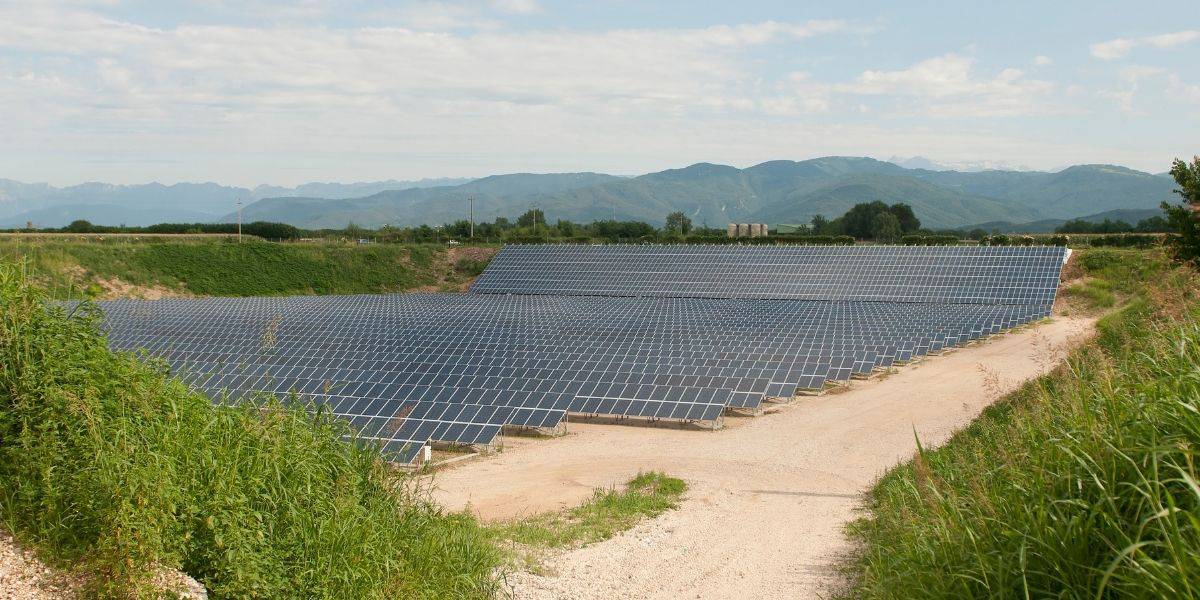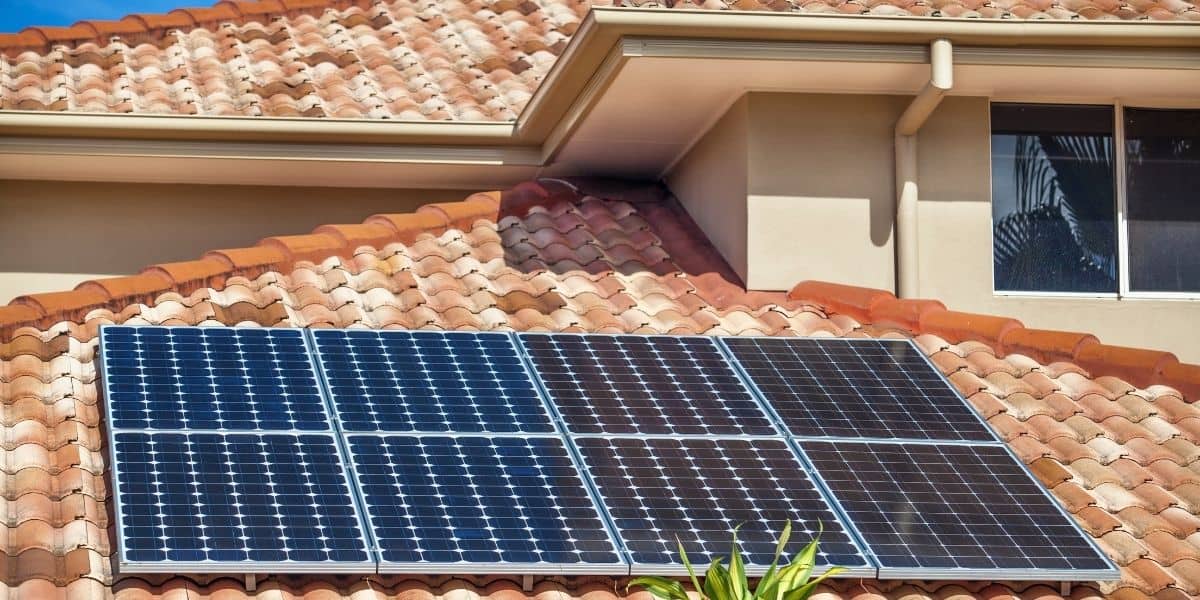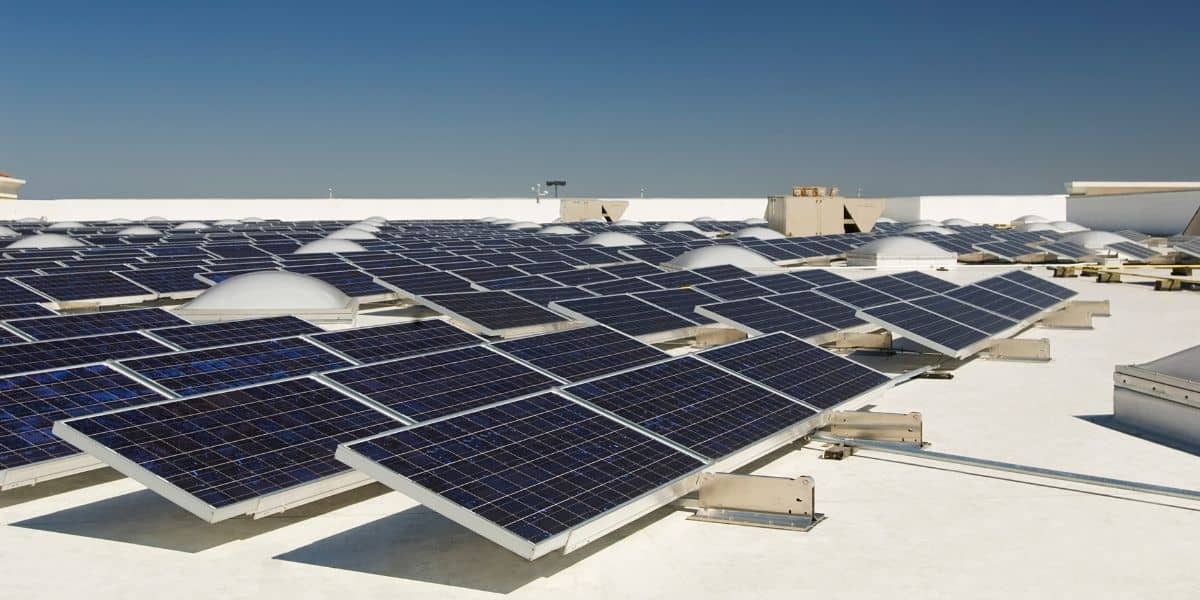If you do a quick search for home solar it’s easy to get overwhelmed with options and confusing estimates. So in this solar home guide, I explain what a solar home is, the answers to basic solar questions every single-family homeowner should know before shopping for solar panels, and how to find a solar company you’ll love in the long run. I’ll also cover solar options for those of you who aren’t ready – or don’t want – to put solar panels on your roof.
Table of contents
- What is a solar home?
- Why go solar?
- Solar power options for residential homes
- Answers to frequently asked solar questions
- Solar panels on different roof types
- Types of solar panels
- Home solar cost factors
- How to pay for your home solar system
- Home solar tax credits, rebates & incentives
- Before you select a solar company
- After the home solar system is installed

What is a solar home?
A solar home gets most of its electricity from a solar PV installation. There are about two million solar PV installations in the United States according to the Solar Energy Industries Association (SEIA). The data on how many solar homes there are in the United States is a bit fuzzy, but Pew Research says 6% of U.S. homeowners say they have installed solar panels at home.
Why go solar?
You may be wondering if solar panels are worth it. The truth is, there are pros and cons to going solar. Here are the top advantages and disadvantages of owning a single-family residence with solar panels.
Advantages of a solar home
There are many advantages of owning a solar home, so I won’t try to cover them all here, but these are my top three.
- Environmental benefits of a solar home – Using solar energy is one of the best ways to reduce your environmental footprint. Buildings (and their construction) account for 38% of all global energy-related CO2 emissions according to the UN Environment Program. To put that in perspective, a 6 kW solar panel system offsets the emissions produced by one fossil fuel car in one year according to EnergySage.
- Solar homes save money on electricity – How much you save over the 20-year lifespan of your solar energy system varies by state, and a lot of other factors go into how much you’ll save. But one example is a 6-kilowatt solar system on a home in California will save the homeowner $40,000 over 20 years, according to EnergySage.
- Solar backup power – If you also get a solar battery for solar energy storage you can use that power if your utility’s power goes down. Solar backup power is a modern alternative to the traditional gas-powered generators of the past.
Disadvantages of a solar home
There are also disadvantages to a solar home PV installation. As a solar homeowner myself, these are the three main disadvantages I’ve run into.
- You have a contract with a solar company – The biggest problem with a solar home is that you need to choose your solar company wisely since you’ll be with them for the life of your solar home system’s contract. If you find a great solar company and the right solar financing for your family this won’t be a problem. But you will need to do your research to get the right fit. I did not do as much research as I should have which has led me to some regrets. (That’s why I highly recommend that anyone shopping for home solar talks to an EnergySage advisor. They can walk you through it all!)
- Solar power maintenance – Solar panels occasionally need to be washed to make them more efficient and sometimes parts need to be fixed or replaced. Make sure to ask the salesperson if you or the solar company is responsible for maintenance. Then find out if there’s a warranty.
- The yearly true-up statement – You will have a yearly true-up statement that reconciles the energy charges, credits, and compensation your solar home accumulated the previous year. If your home had more energy charges than credits you may owe money to the utility at the end of each year. We got a big surprise the first year we got that true-up statement. I highly recommend asking the solar installer how much to expect that the true-up statement will cost.
Solar power options for residential homes
Now that you understand what a solar home is, let’s dig into the many solar power options available for residential homes.
- Grid-tied solar systems offset the energy from your local utility (which gets power from the energy grid) with power from your own solar PV installation.
- Grid-tied solar systems with a storage system allow your home to generate solar energy during the day, store it, and use it at night or when the energy grid cannot supply power.
- Off-grid solar systems do not connect to the energy grid. Instead, the energy is generated on (or near) your property. For the purpose of this article, we will focus on grid-tied home solar systems for single-family homes.
Community solar
A home solar system doesn’t work for every single-family home. Sometimes there’s too much shade on your roof, your roof is too old, or there’s a tree blocking the sun. If that’s the case, don’t get discouraged. There are options:
Community solar is an excellent alternative to putting solar panels on your roof. Community solar is also a solar power option for renters.
Green energy from your utility
Renewable energy from your utility may also be available. Call your local power utility to ask if there’s a local renewable energy option available. Some utilities have a 100% renewable energy option that you can opt-in to.

DIY solar and ground-mount kits
DIY solar panels are another solar power option if you want to skip the solar installer and do it yourself instead. GoGreenSolar sells rooftop solar power kits and ground-mount solar power kits. If you’re super handy and love the DIY aspect, this could be a good option.
Answers to frequently asked solar questions
The energy grid uses multiple sources of energy such as natural gas, oil, coal, nuclear, hydro, sun, and wind energy. The energy grid supplies the vast majority of energy to residential homes, businesses, and cities via the local energy utility. The local utility maintains the electrical lines from the energy source to your home which creates the energy grid.
Solar energy is considered a renewable source of energy because as long as the sun shines you have a source of clean energy.
Energy storage for a single-family residential home will store the energy generated by your roof’s solar panels or straight from the grid in one or several solar batteries. The purpose of solar storage is to allow your home to use the power generated from the sun into power that can be used long after the sun goes down. Without energy storage, solar power can only be used during daylight hours. Energy storage will allow you to have power in the event of an emergency or when the energy grid is not able to supply power.
Solar panels are designed to last at least 25 years.
It takes between one to three days for solar panels to be installed, depending on the size of your roof and how many solar panels being installed.
Solar photovoltaic (PV) is the technology that makes electricity from sunlight. It’s what the rest of us call solar panels. There are several types of solar PV panels, but the most common are monocrystalline and polycrystalline.
Some states allow you to sell your unused solar energy back to the utility through solar net metering. You receive a credit on your energy bill in exchange for the electricity.
Every year you get a True-Up statement from your utility. It reconciles all energy charges, credits, and previously billed monthly electric minimum charges. Basically, when you use more electricity than your solar PV installation generates you pay for that once per year in your True-Up Statement. Be sure to ask your solar salesperson how much the true-up statement may be. If they can’t give you an answer, ask a different company or call your local utility.
A kilowatt is a measure of 1,000 watts of electrical power.
A kilowatt-hour (kwh) is used by utilities as a billing unit for energy.
“An average home needs between 20 and 25 solar panels to fully offset electricity bills with solar,” according to EnergySage.
Solar panels can be installed on a composite, tile, or flat roof.
The average price per watt is $2.81/w in the United States in 2021, but the price varies state by state. The price will also depend on how you pay for them and the solar tax rebates and incentives available where you live.
A solar inverter converts the sun’s energy into electricity. It works as a gateway between the alternating current (AC) current that is produced from the solar panels and converts them into a unidirectional current (DC) that can be used in your home.
The solar contract will stay with the home even when you sell it. The solar contract will be included in the home sale agreement.
“Solar panel efficiency is a measurement of a solar panel’s ability to convert sunlight into usable electricity,” according to EnergySage. “Most solar panels are between 15% and 20% efficient, with outliers on either side of the range.”
Solar panels on different roof types
You can put solar panels on a composite, tile, or even a flat roof. Below you can see examples of what solar panels look like on different roof types.



Types of solar panels
There are three leading types of solar panels on the market today. Monocrystalline, polycrystalline, and thin-film solar panels according to EnergySage.com. A good sales representative should walk you through the pros and cons of the different types of solar panels.
- Monocrystalline solar panels are more efficient and expensive than polycrystalline solar panels. They have a black hue. They work well on smaller rooftops since they need less area.
- Polycrystalline solar panels are less efficient and expensive than monocrystalline solar panels. They have a blue hue. The less efficient panels may save you money if you have a lot of roof space.
- Thin-film solar panels are the least efficient but they are the most flexible.
Home solar cost factors
A lot of factors go into the cost of a home solar system.
Solar panel installation – If your roof is already slanted and facing the sun it may be less expensive to install than if the home solar system needs to be built up. If the roof is flat or the panels can’t be placed to face the sun, the system will be built up for maximum sun exposure. These factors affect the price of installation.
The type of solar panels – Monocrystalline solar panels are usually more expensive and efficient than polycrystalline panels and may be necessary for a small roof. Polycrystalline panels are usually less expensive and efficient but may save money if you have a large roof with lots of space. Ask your sales representative if paying for the more efficient panels is necessary.
The number of solar panels – The number of solar panels you use will also impact the price of your home solar system.
Connecting to the grid and permits – Your solar system will need to be connected to your local utility so you get electricity when the sun goes down. You’ll also probably need permits, so make sure to ask your potential solar company who will take care of the connections and permits.
How to pay for your home solar system
Cash is the simple way to go if you have the cash and you’re willing to spend it on a solar system rather than another investment. If not, there are other ways to pay for your home solar system that doesn’t require putting a lot of cash down.
Residential solar financing options
Solar financing – You own the home solar system but you borrow the money from a bank or credit union. Financing solar is similar to financing a home. You own it, but you make payments each month. Some people use a home equity line of credit for solar instead.
Solar power purchase agreement (PPA) – A solar power purchase agreement (PPA) is a contract between you and a company that owns and installs a home solar system on your roof or property. The company sells the power to the utility, and the property owner pays the company a monthly fee. The power purchase agreement is usually 10 – 25 years. The company owns the system and is responsible for maintenance. Some PPA contracts allow the homeowner to buy the home solar system after a period of time.
Lease solar panels – Some states allow the solar company to lease the solar system directly to customers. A solar lease is similar to a PPA, but the company does not sell the electricity back to the utility. It’s similar to a car lease in that you do not own the system at the end of the contract. You may be able to buy the system after a period of time if that’s included in your contract.
Only the owner of the solar system qualifies for most tax credits and SREC’s so you may not qualify for them with a PPA or solar lease. A lot has been written about the problems with solar power purchase agreements and leasing solar panels, so be sure to do your research before you sign a solar lease or PPA.
Resource: Cancelling a solar lease contract
Home solar tax credits, rebates & incentives
Investment tax credits – Qualifying homeowners that purchase a home roof solar system can deduct 26% of the cost of the system from their taxes in 2021 according to EnergySage.com.
State and local solar incentives – Each state and utility have their own incentive program. Go to DSIREUSA.org to find specific solar rebates by state and the local solar incentives available in your area.
State solar renewable energy certificates (SRECs) – Some states require utilities to purchase SRECs that go toward their Renewable Portfolio Standard (RPS). In states with SRECs, homeowners with rooftop solar are paid cash by the SREC market for unused solar credits. Make sure any contract you sign lets you keep that cash rather than the solar company.
The difference between net metering and SRECs is how you get paid for unused solar energy. In states with net metering, you receive a credit from your utility. In states with SRECs, you receive cash from the SREC market in exchange for the utility taking credit for the clean energy you produce.
Only the owner of a solar panel system can sell the credit, so if you lease your system you can’t get paid for the SREC because you don’t own the system.
Before you select a solar company
Now it’s time to dig a little deeper into the essential steps you need to take before purchasing solar panels. Start by using a solar home calculator, then contact at least five local solar companies for quotes.
Use a solar home calculator
EnergySage has the best solar home calculator. Not only can you get an estimate for your home in less than two minutes, but you can also sign up to get multiple quotes from solar companies that let you compare solar estimates apples to apples.
NREL’s PVWatts Calculator is another reliable solar calculator.
Get multiple solar quotes
The most important thing you can do when shopping for solar panels is to get multiple quotes. I can’t say this enough. The solar energy market is competitive and you have lots of options. A few good places to start your research include EnergySage and SunPower.
(Note: Links marked with an asterisk* are affiliate links and I may receive a commission if you purchase solar through these links.)
EnergySage* is the most comprehensive source of information about solar energy you’ll find. EnergySage will give you multiple solar quotes and allows you to compare estimates in an easy (apples to apples) way. Plus, you get access to a solar advisor that’s highly educated in all things solar.
SunPower* is another excellent solar company that’s approved, screened, and verified by EnergySage. Learn everything you need to know about SunPower’s solar panels and energy storage before you even contact them.
“We hold the world record for the most efficient and most durable solar cell on the planet. We have over 700 industry patents, and we are the only solar company that has been around longer than our own 25-year warranty,” according to Jensen Chapman from SunPower.
Questions for solar installers
The best way to find the solar installer and company you’ll love is to ask a lot of questions! Here’s a comprehensive list of questions to ask the solar salesperson before you sign a contract. This checklist is another useful solar resource to refer to while getting solar quotes.
Related: Three questions to ask every solar company
Read the reviews
Before you decide on a solar company, look for reviews and research complaints against the company.
- Check the Better Business Bureau to see if the solar company you’re considering has a good rating with the BBB or if there are many complaints.
- Check EnergySage’s comprehensive list of reviews of solar companies from all over the United States.
Call the solar installer’s general number
When you’ve finally narrowed down your choice to one or two solar companies call their general customer service number. This will show you how well the solar company’s customer service does for current customers that have already signed the contract. Even well-known solar companies have can have terrible customer service and that’s not something you want to find out after you sign the contract.
It may seem like a lot of steps, but if you want the best solar panels and to sign a contract with a reliable solar company, it’s important to do your homework.
After the home solar system is installed
When the solar panels are installed, the final step is full home electrification. That’s a fancy way of saying using all-electric energy at home rather than natural gas. Take it step by step and don’t rush. Getting a home solar system is a big first step toward lowering your home’s environmental footprint and lowering your energy bills.
